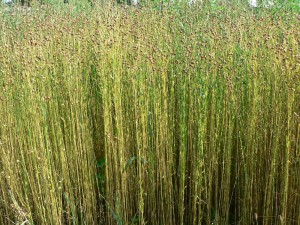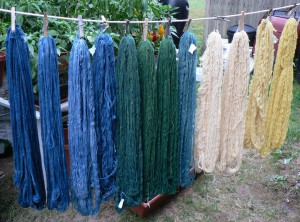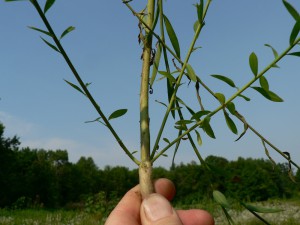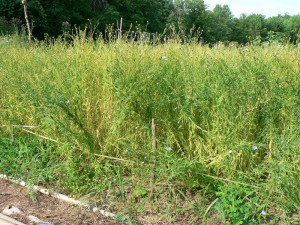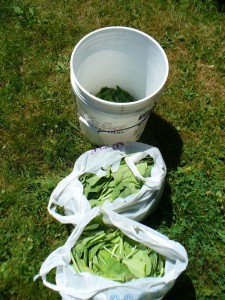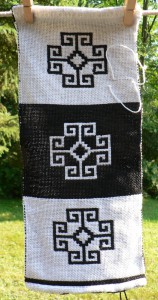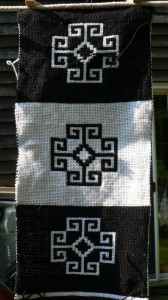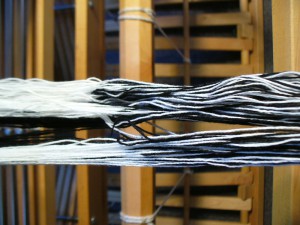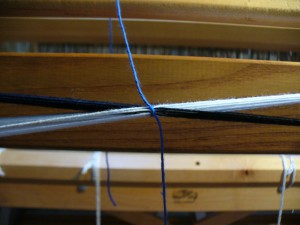Last year, 2011, I grew flax in two locations: our community garden plot and Bramble Hill Farm. The plot at Bramble Hill was about 4 feet by 15 feet. I planted on May 1st and harvested on August 1st (nice and festive). At the community garden I put in two beds 3 by 30 feet, but I got it in really late: May 29th. Also, we had the plot rototilled, rather than digging it over by hand as I usually do. Perhaps for both these reasons, it got really overrun with weeds, primarily grass. I wasn’t very pleased with the quality of the flax fiber-wise, so I decided to try saving it for seed. I let it stand much longer than I normally would have, and didn’t harvest until October 6th, which was 122 days after planting. I found to my dismay, however, that most of the seeds were immature. Later I finally learned that the flowers require pollination by insects, including bees, to be fertilized. I also found that the dry seed heads shatter easily, and a lot of the seed had fallen onto the ground before I harvested. And, thanks to close observation this summer, I can now assert with confidence that small creatures were probably eating the seeds. Continue reading “Retting Last Year’s Flax”
Flax Harvest at Amethyst Farm
Back on July 16th I pulled the flax at Amethyst Farm. It was the last plot I harvested, and ideally I should have pulled it about a week earlier, judging by how many stalks were totally brown and dry by the time I got around to it. We had some extremely hot weather that put those poor plants right over the edge. But you do what you can do.
Here’s the Evelin seen from the south side of the plot.
Marilyn at Amethyst Brook
Well, I thought I was done writing about the flax harvest at Amethyst Brook, our community garden plot, but I forgot to write about the Marilyn. Partly this is due to the fact that my camera started to die around this time, and I didn’t get a lot of photos. The Marilyn, as you may recall, had been the first variety to suffer from lodging. If you don’t recall, because you’re very reasonably not obsessed with all my flax triumphs and woes, I’ll recap. Continue reading “Marilyn at Amethyst Brook”
Queen Anne’s Lace and Woad
Supposedly this blog is about dyeing. Even though I don’t seem to write about it very often, I do sometimes actually dye things. This week I had great success with woolen yarns using Queen Anne’s Lace flowers. Plus I managed a successful woad vat, aerated and everything. Here are the lovely yellows, greens, and blues hanging on the line to dry in the back yard (each skein is about 4 ounces).
More Flax Harvesting at Amethyst Brook
In the last post I forgot to show these images of a particularly robust v.n.s. plant. The thicker stalks tend to be around the edges of the plot. This is one of the reasons, I imagine, that people usually recommend against planting in row. If you have a continuous plot, you have less edge-area relative to your total square feet. However, I can’t reach in to weed anything wider than 4 feet. If you don’t weed, in my experience, the weeds overwhelm the flax.
However, you can see several undesirable characteristics here from a fiber point of view. For one thing, it’s a very thick stalk.
Here you can see branching at the bottom of the stalk. This may reduce the length of potential bast fiber by a couple inches. Whatever extends down into the root is presumably going to detach from the rest below the branches, though again it’d be good to see this under a microscope to see what’s really going on. Continue reading “More Flax Harvesting at Amethyst Brook”
Flax Harvest at Amethyst Brook
On Friday July 13th and Sunday July 15th I harvested the flax at our community garden plot at Amethyst Brook. It took two days because there were a lot more plants in these plots, and because the v.n.s. and the Marilyn had such a problem with lodging that they were a mess to sort out and bundle up.
Here’s the v.n.s. looking toppled after it got knocked down three times or so, and I tried to encourage it back to a more upright habit. But once it went down, it was down.
Flax Harvest at Small Ones Farm
Between Wednesday July 11th and Monday July 16th I pulled up all my flax. I started a bit earlier than 90 days after planting (I planted all the plots the same day, April 15th), and earlier than 30 days after peak bloom (which was around June 21st). These had been the two harvest benchmarks I had in mind all summer. However, we have had such hot, dry weather that despite my diligent watering efforts the flax was just done. Usually people recommend pulling it up when the lower third of the stalks turns yellow. I have typically pulled it when more like half or even two thirds of the stalk is yellow. You can see in the photos that this year a lot of the flax was entirely yellow, and a few stalks had even begun to turn brown. Continue reading “Flax Harvest at Small Ones Farm”
Woad Vat Mishap
The other day I very excitedly set about my first woad vat of the summer. There were lots of supplies and equipment to assemble, dirty 5 gallon buckets to wash, yarns to soak. I got everything ready, and harvested seven and a half pounds of leaves from my glorious woad beds. You can tell from the title of my post that I made a big mistake along the way, but I hope to turn it into a learning opportunity for others, so I relate the tale….
Here are the bags of leaves. They were very clean because we have had practically no rain. Sometimes the leaves are muddy so I rinse them off, but not this time.
Doubleweave Pick-Up
Doubleweave pick-up is a way to weave a reversible pattern by manually picking up the threads from the bottom layer and bringing them to the top. In those same areas, the threads from the top layer show up on the bottom. Before I go any further, here are the two sides of my sample so you can picture the end result as I describe the process.
Colonial Doubleweave
July has been a very busy time, what with all the watering (it’s been hot and dry), squishing of bugs, and weeding, not to mention flax harvesting. However, I recently did a tiny bit of weaving for my double-weave study group with the Pioneer Valley Weavers Guild, led by the elegant and brilliant Barbara Elkins.
Doubleweave is a versatile technique that lets you weave two layers of cloth at the same time. The layers can be joined at the right or left edges, joined at both edges, they can be totally separate, or they can exchange periodically (i.e., the bottom layer comes to the top and the top layer goes to the bottom). Our samples used four shafts, which is the minimum number you need.
The whole process has been full of visual surprises, beginning with winding the warp. For our samples, we wound a warp with two alternating colors. I chose black and white for maximum contrast. On the left, below, is the cross with my counting thread. You can see the separation of the white and black layers. On the right is the warp as I was beaming on. The alternating black and white ends get sorted into their respective layers when they go through the lease sticks. In the section of the warp that hasn’t yet been beamed on there is a cool transition between where they alternate and where they become separated. I warp back to front, so this un-separated section is in the front of the loom.

